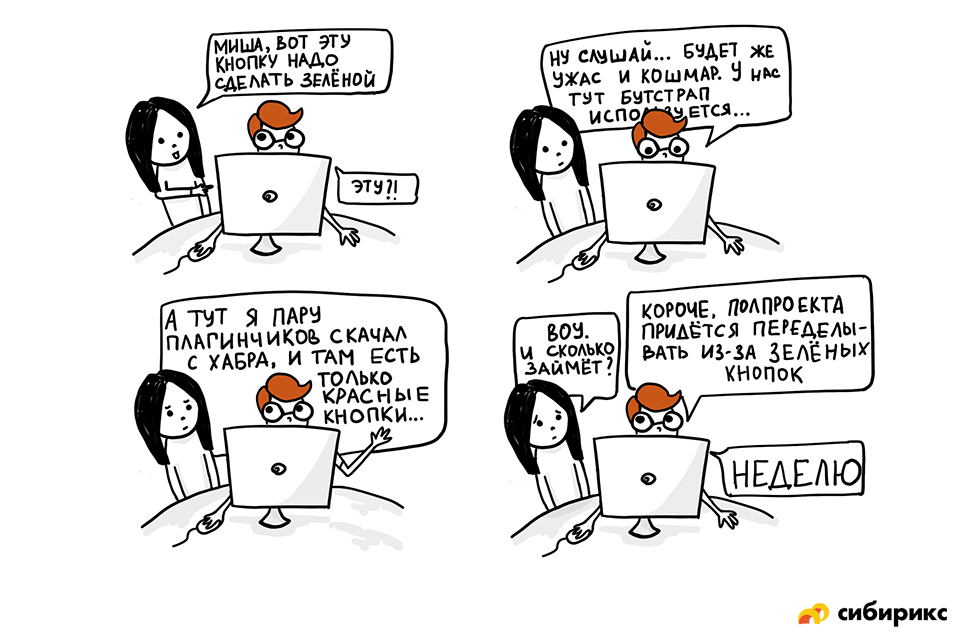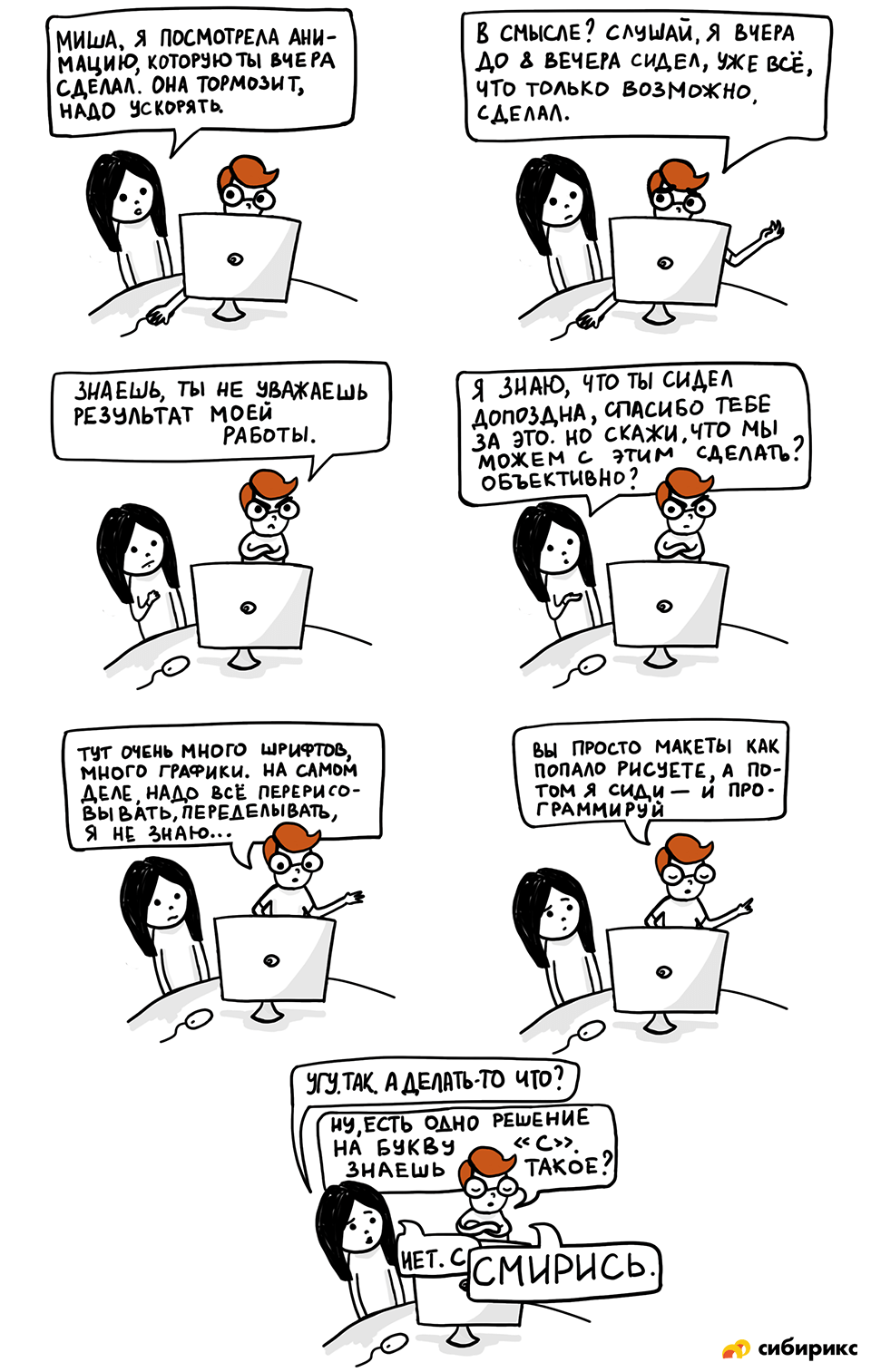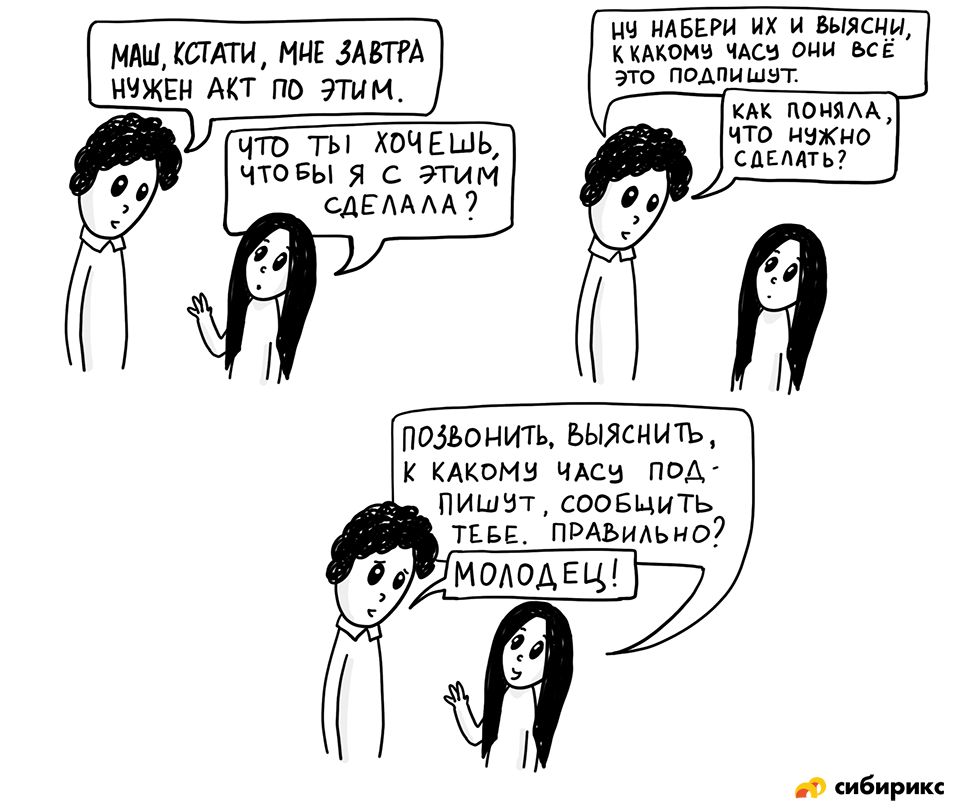Man's bugfix: how to fix bugs that interfere with work
Why people can not take - and complete the task? Where do the hiccups, wrong estimates and procrastination come from? Why do people not understand each other, although it seems that they are not fools and communicate in the same language?
As it turned out, the reason for all this is one - cognitive distortion. We will talk about them.

Cognitive distortions are bugs in the human psyche that prevent objective perception of reality. There are many of them and they are found in each - on the Wikipedia page in the list of cognitive distortions under 130 points, and 129 you will most likely find yourself. These include the power of the first impression, the desire to justify himself, and even the reason why we cannot give an adequate assessment of the problem.
Cognitive distortion - like bad habits. You can live, but it would be better to end them. And here with bad habits is even simpler: at least we know that smoking or sharpening pizza under cover of night is a sin, and we should stop it one day. And if you don’t know cognitive distortions, you don’t even know what to fight with. The brain itself is against it (but more on that below).
Since cognitive distortions make it difficult to work, to understand each other and, as a result, to perform tasks, you need to get rid of them. This applies to managers, developers, designers, analysts, copywriters - all. In an ideal world, each person himself catches and fixes his distortions, but in reality, as we know, without testers (from the side) this rarely happens. So be prepared: if you do not fix your bug, one day others will come to the rescue and force you to do it. And I will tell you exactly how :) I will not consider all 130 distortions - I will only go through those that were caught in our studio and which are often found among IT workers.
Generalization of special cases

The generalization of special cases is a cognitive distortion, due to which a person expands the set task. However, he does not even realize that it can be done easier and faster. Most often found in programmers and rarely fix themselves. To correct this cognitive distortion, you need the help of a manager. At least once he will have to turn on the monitor control mode.
There is a bike that lizard bites the victim, while poisoning it. The poison does not act immediately, so after the monitor lizard goes for the bitten and waits for it to die. And already then eats.
Just as intently as a monitor lizard at his future dinner, the manager should follow the work of the developer or designer. Unlike animals from the wild, they do not die from this, but - lo and behold! - it is done, and the monitor lizard remains hungry :) By the way, programmers are only unpleasant at first (well, the very idea that they will be treated like that) is unpleasant. Further, oddly enough - a person is drawn in and leveled.
This method is guaranteed to put the brains in place and reduces the procrastination - and as a result it turns out that instead of a week, the task can be solved without much effort in one day. Or an hour. Or 20 minutes. Well, you understand.
It's impossible!
')

Among cognitive distortions, we can distinguish a whole group of those who are preventing us from starting the task. They, too, are more common with programmers and designers, although sometimes they also jump with managers in response to customers' wishes. And usually expressed categorically: "This is impossible!".
This reaction has several reasons:
- too lazy to understand the new problem;
- the effect of resistance has worked, and the person wants to prove that he himself is free to decide what to do and what not;
- the task contradicts the sense of beauty.
This bug is easier to catch yourself. You just need to remember and believe that there are no impossible tasks. They remembered - and think about what resources are needed to complete the task.
If you caught this cognitive distortion from a colleague, ask him the same question that you would ask yourself: "Tell me, please, what do you need to do this task?". And repeat it until a colleague realizes that they do not believe him, and indeed the task is not so impossible.
Well, in the future, if the situation repeats, you will have a case for “This is impossible!”, As a person, with the same diagnosis, solved the problem in N minutes. Remind him of this case a couple of times - and then he will learn to fix this bug himself.
Curse of knowledge

The curse of knowledge is a situation where a more informed person cannot consider a problem from the point of view of a person who knows less. From here, by the way, so many misunderstood geniuses. Even more among managers than among programmers or designers. Basically, this bagulya is encountered by inexperienced managers - to whom it seems that it was an obvious decision to do HERE that wasn’t even necessary to pronounce (which, of course, was not done and not formulated in the task). And the fact that the programmer / designer / analyst did not understand this is his cant. Of course, this needs to be fixed.
The curse of knowledge is eliminated by self-training. You need to catch your illogical behavior and step on your tail. Trying to build a constructive dialogue, even if you really do not want to. You can live your whole life thinking that everything around is stupid, and you alone are beautiful in a coat. But in fact it turns out that everything is quite the opposite.
Personal insult

The next cognitive distortion is when criticism of the result is perceived as a personal insult to those whose work is criticized.
This distortion is often found in creative personalities. Especially if they have not slept in a bad mood. Emotions speak for a person, so he rarely can control himself, he is offended and pours objections. To steer such a situation into a constructive and not to offend anyone, you need to act according to the following algorithm.
- Separate good and bad.
- In the work, even if it needs to be redone, there were still some positive moments - remember them and praise your colleague.
- Explain what the error is. Perhaps the person does not know how to correct this mistake, and that is why it resists and rebels.
- Initiate a re-discussion or brainstorm on already completed questions.
- Ask for help from colleagues or allocate an additional resource - for example, time for a survey.
- Insist on reworking the bad.
- Fix the lesson learned: find out the reason why the distortion was activated, and remember how you fixed it.
Generation effect

I give my due: not all cognitive distortions are the cause of problems and misunderstanding. There are also useful. For example, the “generation effect”. Due to this distortion, a person memorizes information better when he reproduces it himself, and does not perceive it from the outside. Therefore, if you doubt that you have correctly understood the task, or are afraid to forget - just repeat it out loud.
Something similar is in the aviation regulations. When the controller on the ground transmits some information, the pilot in the plane must repeat it all. In such a situation, the cost of the error is high, so repetition is necessary, firstly, in order to eliminate interference and other communication lazhes. Secondly, the pilot managed to set the necessary parameters while listening, and simply counted them from the instruments when responding. And, thirdly, in order to consolidate the received information with the generation effect - a bonus.
So do not be afraid and do not hesitate to repeat productions - this is a real working method, tested by pilots.
Blind spot

This is exactly what I mentioned at the beginning of the article - the brain does not want to notice its imperfections. Therefore, there is a blind spot in relation to cognitive impairment. Even if a person knows about them, it is unlikely to agree that they affect his behavior. And the consequences will write off on the circumstances and the stupidity of others. And, accordingly, will not do anything to fix its cognitive distortions.
Therefore, if you notice that tasks are done with knots and hitch, and you want to change this - try to evaluate objectively, maybe the reason for this is cognitive distortion? If it seems to you that of course not - it is better to ask colleagues just in case. The blind spot does not apply to other people's bugs :)
Now, when you know about cognitive distortions, and even understand exactly where they stick out and interfere with your work, you can deal with them. Of course, it will be difficult at first, and even the blind spot will interfere. But over time, it will decrease. And then it will be easier for you and your colleagues to live and work - there will be less unexplainable crap and more constructive, peace, friendship and chewing gum in the processes.
What is described in this article is the tip of the iceberg of cognitive distortions and anomalies in the work of our brain. If the topic caught you and you want more - I recommend reading these books:
- Oliver Sachs. The man who took his wife for a hat
- John O. Cooper, Timothy E. Heron, William L. Heward. Applied behavioral analysis (a couple of introductory chapters can be found here )
- Cialdini R., Kenrik D., Neuberg S. Social Psychology. Understand yourself to understand others
- Cialdini R. Psychology of influence. Convince, act, protect yourself
Source: https://habr.com/ru/post/330784/
All Articles